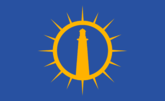Republic of New Somerset
Republic of New Somerset République du Nouveau Somerset Republik av Nya Somerset | |
|---|---|
| 'Motto: 'Liberty, Conservation and Respect bring Unity | |
| Anthem: Fogarty’s Cove | |
| File:New Somerset is located in Maine | |
| Capital | Delphorage |
| Largest city | Baccalieu-Orabo |
| Official languages | English French Espenisch |
| Demonym(s) | New Somerese |
| Government | Constitutional Stratocracy |
• Lord Marshall of Salacia | Otto Green |
• Lord Marshall of Saint Andre and Baccalieu | James Christian |
| Legislature | Maritime Parliament of Adjitor-Andre |
| Establishment | 16 May 2022 |
| Population | |
• Census | 25 |
| Currency | Macareux Florin |
| Time zone | UTC-4 |
New Somerset, officially the Republic of New Somerset, is a sovereign state with a constitutional monarchy-junta, often characterized as a micronation. New Somerset is located on the eastern seaboard of North America and is an enclave country completely surrounded by the United States and Canada. New Somerset claims 5.1 kilometers of territory and has a population of 25, of which 15 reside within the Republic.
The islands which make up New Somerset were settled by various Native American tribes throughout history, independence of New Somerset was declared by Lord Marshals Hunter Smith and Otto Green, after centuries under American and Canadian sovereignty. The Lord Marshals, currently Hunter and Otto, is the official head of state who have specific and notable powers within the Republic, including passing legislation and acting as head of state and government. The legislative body of New Somerset is the Maritime Parliament of Adjitor-Andre, a bicameral body which has the authority to review and pass legislation on to the Lord Marshals. The Republic's judiciary is comprised of the Maritime Court of New Dijon. New Somerset is comprised of four non-contiguous territories, Serene Republic of Saint Andre and Baccalieu and Maritime Republic of Salacia, New Dijon, found within Salacia serves as the administrative and judicial capital, while Orabo-Baccalieu found within Saint Andre and Baccalieu serves as the diplomatic capital.
Etymology
The name "New Somerset is derived from the 1622 patent of the Province of Maine was split at the Piscataqua River into the Province of New Hampshire to the south and New Somersetshire to the north. A disputed 1630 patent split off the area around present-day Saco as Lygonia. Justifying its actions with a 1652 geographic survey that showed an overlapping patent, the Massachusetts Bay Colony had seized New Somersetshire and Lygonia by force by 1658.
The name has taken on a new meaning as the merger finalized, within the Republic "New Somerset" has come to recognize the connection between the regions and the United Kingdom, as well as the historical and cultural ties to the French Acadians that were removed from some regions of New Somerset.
History
The idea was brought forth by Otto Green in conversation with Hunter Smith, regarding cooperation between the two young states. Both soon discussed what a united nation would look like and agreed that in light of both men being the main driving force behind their own nations, merging would provide both men some support and help with projects. The Treaty of New Dijon was signed on 4 May 2022 resulting in a shared currency, armed forces and direct lines of communication were defined.[1]
After the treaty was signed further ideas and proposals started flowing in from Mr.Green and citizens of Saint Andre and Baccalieu, including drafting a proposed constitution highlighting the government, rights and functions of citizens. During the conversations, the name of New Somerset was decided in light of the former name of a Maine colony under the British Empire as well as paying homage to the region of Newfoundland which was apart of the British Empire until it joined Canada in 1949. Mr.Green and Alec Hanson of Saint Andre and Baccalieu discussed at length the contents of the constitution and on the morning of 6 May the constitution was sent to the governments of both nations. On 16 May, both nations signed the constitution marking the start to the Republic.
Government and politics
New Somerset is governed by a unitary constitutional monarchial junta. The New Somerset head of state and government are the Lord Marshals of Salacia and Saint Andre and Baccalieu. The legislature of the Republic is the Maritime Parliament of Adjitor-Andre.
The Maritime Parliament of Adjitor-Andre is comprised of two chambers, the House of Adjitor and the House of Andre. The House of Adjitor oversees any final policies before being sent to the Lord Marshals and includes the House, Citizen Affairs and Defense ministers as well as the Lord Marshals. The House of Andre is composed of all citizens of the Republic and meets a minimum of four times a year to discuss any concerns or questions with the government.
Monarchy
The Monarch, often referred to as the Lord Marshals are the official head of state and government of New Somerset. The Lord Marshals have royal duties, as well as governmental duties including, publishing decrees, running government and managing the various constituent countries of the nation. The current Lord Marshals are Hunter Smith and Otto Green, they are the founders of Saint Andre and Baccalieu and Salacia. The Lord Marshals serve as an unbiased and non politically affiliated member of government and of the entire nation, often seen as the unifying power of the nation.
The line of succession to the New Somerset thrones is similar to many historical lines except that it is male preference, however female heirs can be appointed by approval of both Lord Marshals or if a male heir can not be found. The system was agreed upon within the ruling House of Beechnear, to ensure there is a traditional monarchy, but follows a more modern system of acceptance of females within royal families.
Law and order
The Basic Law of New Somerset is the law of the country, and consists of written text and unwritten conventions. Further policies have affirmed governance based on the unitary precedent and the powers given the Lord Marshals. New Somerset's judiciary plays an important role in interpreting laws and has the power to strike down Lord Marshal decrees. The Maritime Court is the highest court and final arbiter and has been since the foundation of the state in May 2022. The Maritime Court is made up of one member from each constituent country, currently making the high court being made up of three judges. All judges are appointed and approved after consultation with the Lord Marshals and the House of Adjitor. The Chief Justice leads the high court and is elected from among the judges of the high court every six months.
Common law prevails everywhere within New Somerset. Criminal law is solely the responsibility of the Lord Marshals and is uniform throughout New Somerset. Law enforcement, including the lower courts are officially the arrondissement's responsibility. However the law enforcement responsibilities are outsourced to the Puffin Guard given the low levels of crime and public disturbances within the nation.
Military
The nation employs a volunteer military force of approximately eight active personnel. The Puffin Guard comprises of two branches, the Baccalieu Divisions and Flying Puffin Legion, however the duties of the Puffin Guard range from costal defense, exploration and the opportunity of military education. Due to the fledging size of the state and its part in being a volunteer force, the military expenditure is not defined and often reflective of the interests of its members and what equipment personnel are wishing to use.
Foreign relations
New Somerset is a unrecognized minor power within the micronational community. New Somersetan foreign policy based on neutrality and peacekeeping and is carried out through partnerships and mutual recognition treaties with fellow micronational states. The strategy of the Smith-Green's government foreign policy reflects the emphasis to maintain a neutral stance in the face of international disputes. New Somerset shares a border with Canada and the United States, however the nation does not define itself as being "Canadian" or "American" but being Andri and Salacian and due to the fledgling size and age of the nation, New Somerset does not share close ties with any micronation, however its first diplomatic partner was the Kingdom of Aspen. New Somerset currently recognizes two micronations and is currently not a member of any intermicronational organizations.
Geography
New Somerset is comprised of four non-contiguous territories: Salacia, Saint Andre and Baccalieu. Saint Andre and Baccalieu is the largest of the Republic's territories by land area with three islands. All of the territories in the Republic are made up of small rocks and islands, except Baccalieu Island which is five kilometers in area. The territories of New Somerset are off the coast of the United States and Canada located in Maine, Newfoundland and Labrador and Quebec. Baccalieu Island, Matinicus Rock and Hog Island Ledge are all home to lighthouses, except the later which is home to the former active military base built in 1865.
Climate
New Somerset has a humid continental climate (Köppen climate classification Dfb) with warm, humid summers and cold winters. Compared to the mainland, seasonal climate fluctuations are somewhat moderated by the Atlantic Ocean, resulting in relatively cooler summers and milder winters. Springs are also some of the coolest in the region. Summers are almost nonexistent due to the moderating effect of the ocean, which also helps to keep year round temperatures above zero and below 75. The common winter freeze and thaw cycles produce much slush. Nor'easters, can be destructive to the shoreline and infrastructure on the island.
| Climate data for New Somerset | |||||||||||||
|---|---|---|---|---|---|---|---|---|---|---|---|---|---|
| Month | Jan | Feb | Mar | Apr | May | Jun | Jul | Aug | Sep | Oct | Nov | Dec | Year |
| Average high °C (°F) | -0.8 (30.6) |
-1.1 (30) |
1.0 (33.8) |
5.6 (42.1) |
11.1 (52) |
15.8 (60.4) |
20.7 (69.3) |
20.5 (68.9) |
16.5 (61.7) |
10.8 (51.4) |
6.4 (43.5) |
1.8 (35.2) |
9.0 (48.2) |
| Average low °C (°F) | -8.2 (17.2) |
-8.6 (16.5) |
-6.1 (21) |
-1.9 (28.6) |
1.7 (35.1) |
5.9 (42.6) |
10.9 (51.6) |
11.6 (52.9) |
8.2 (46.8) |
3.9 (39) |
-0.3 (31.5) |
-4.7 (23.5) |
1.0 (33.8) |
| Source: Environment Canada | |||||||||||||

